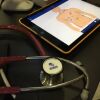It’s March 4, 1990, with 13:34 left in the first half of the basketball game. Loyola Marymount University player Hank Gathers suddenly collapses onto the court. He tries to get up, but slumps back to the floor. Despite efforts to revive him with a school defibrillator, he eventually dies at the hospital.
From his death, two years later ProSportsEMS was born. The sports paramedic program has since spread throughout the U.S. as a way to support local sports franchises and provides remarkable sophistication designed to train, support and equip athletic trainers for advanced first aid.
While at first it appeared the program would be best used to deliver better care in the sporting venue, it soon became clear there was an area of even greater concern: constant air travel.
Team physicians usually don’t travel with professional sports teams as the players jet across the country to games, and at 30,000 feet, an EMS provider or ambulance could easily be more than an hour away. The first minutes of care take on a new perspective. They are likely to be the only minutes that matter in a true life-threatening emergency, especially so far from any licensed emergency responders.
With this in mind, ProSportsEMS developed a specialized kit including AEDs, SGAs, EpiPens, Narcan, Abuterol, Nitro, Oral Glucose and Glucagon — even Baby ASA — to prepare trainers for remote care. They also offer a MEDKIT mobile app, for instant access to protocols. It is updated regularly, so providers have access to the latest guidelines.
Through this and other initiatives, the ProSportsEMS program integrates specially developed protocols with equipment, training and medical direction. It relies on personnel who are always available wherever the team goes, usually the athletic trainers.
Why athletic trainers are ideal candidates for EMS training
Initially, the program was a way the Phoenix Fire Department could support the local NBA franchise. At the time, Phoenix Fire provided two paramedics with equipment to the Phoenix Suns to assist their medical staff during home basketball games.
But the current program is unique in that it offers an elegant and comprehensive solution to a longstanding challenge of further protecting athletes by educating the athletic trainers in charge of their care.
ATCs are often the best choice for three key reasons:
- They are present and are able to witness the event or mechanism of injury — a luxury first responders rarely get.
- They have a great background to build upon. Many have masters degrees along with an in-depth knowledge of anatomy and physiology.
- ATCs know their athletes’ intimate medical history better than almost anyone else. From a recent minor injury to ongoing rehabilitation from major surgery, the trainer knows what is going on. He or she knows special treatment considerations for every team member and often many of the supporting employees.
And, the model has proven successful.
Since its inception, ProSportsEMS has evolved into a business that now serves the NBA and other sports teams across the U.S. Local fire and EMS services have helped provide emergency medical care to more than 1,600 events including the NBA Finals, Stanley Cup Playoffs and World Championship Boxing.













